The trade deficit expanded in 2018 to its highest level in at least a decade, even though candidate Donald Trump promised to dramatically narrow the gap. A big reason for that $878 billion deficit is the health of the U.S. economy. Consumers are flush with cash, and they’re spending it. The trade deficit always goes up when the economy is strong and plummets when the economy sinks, as it did during both the Great Depression of the 1930s and the Great Recession of 2008–09.
More travel to America would lower our trade and budget deficits.
The trade deficit expanded in 2018 to its highest level in at least a decade, even though candidate Donald Trump promised to dramatically narrow the gap. A big reason for that $878 billion deficit is the health of the U.S. economy. Consumers are flush with cash, and they’re spending it. The trade deficit always goes up when the economy is strong and plummets when the economy sinks, as it did during both the Great Depression of the 1930s and the Great Recession of 2008–09.
Still, the near-trillion-dollar trade deficit is a black eye for Trump, and there are some important steps he could take to bring it down. One is to get the trade deal done with China to level the playing field and expand American markets to the billion-plus Chinese.
While Trump policies have given a big boost to manufacturers and the construction industry, perhaps it’s time to tout another critical but underappreciated export industry: travel and tourism.
My new report on the economic impact of travel and tourism has found that in 2017, more than $1 trillion of GDP was added to the economy by this industry alone. Today almost nine million jobs are directly or indirectly related to the industry and the injection of dollars into the economy when foreigners spend their money here.
Workers in the travel industry earn about $260 billion in wages, which is spending power in its own right. Many of these jobs in the hotel and hospitality industries are starter jobs — which are critically important to getting young Americans planted into the workforce and off the living-room sofa or their iPads. But several million of these jobs are high-paying, with incomes well over $75,000 a year.
What is not well known is that when foreigners travel to the U.S., they alone help create 1.2 million American jobs — which is many multiples more than the number of steelworkers we employ. Every dollar a foreigner spends over here directly subtracts a dollar from the trade deficit.
And what a product we in America have to sell. Is there any nation on earth that has more natural attractions, from the scenic coastal towns of Maine to the volcanic islands of Hawaii and the natural beauty of our majestic national parks? Add to that top tourist destinations from Manhattan to Manhattan Beach, and America should be far and away the world leader as a destination of choice.
We don’t know precisely how much foreigners spend while they are visiting inside our borders, but the best estimate by the industry is roughly $250 billion. Believe it or not, foreign travel is one of our five largest “export” industries.
Our goal should be to attract 100 million foreign travelers a year — which would mean about a 20 percent increase over the next three years. This would add at least $50 billion of sales of goods and services in our economy and lower our trade deficit by an equivalent amount.
Even a very good pro-America trade deal negotiated by Trump with China will be hard-pressed to lower our trade deficit by that amount. Trump should aim to get more Chinese to visit the U.S., and our trade deficit would fall as a result. After all, it doesn’t matter to our industries whether a foreigner buys American products — from food to cars to computer software — here or in their home country.
This increase in foreign travel and foreign purchases also would increase state and local tax revenues by about $25 billion a year — helping pay for schools, police, health-care coverage, and roads. It would also create about 300,000 more American jobs.
What steps could be taken to increase travel to the U.S.A.? Make it easier for foreigners to come, and spread a more welcoming message to the rest of the world. The travel industry itself will have to do this mostly itself, but it would be helpful if President Trump and all our political leaders helped promote the U.S.A.
Other steps to make it easier for foreigners to travel to the U.S. would also bring more spending money into our borders. Expanded global entry (for those coming from friendly countries) and more expedited entry through our ports and airports would make entering and leaving more hassle-free. Then our security personnel could concentrate their resources on the growing problem of drug runners, terrorists, and criminals.
America needs to lay out the welcome mat to tourists, students, and business travelers from abroad. This is a way to continue to supercharge our booming economy without costing taxpayers a single penny. In fact, more tourists means lower trade AND budget deficits. Is there a less painful way to accomplish those twin goals? If there is, can someone please let me know what it is.
This piece originally appeared in The National Review




